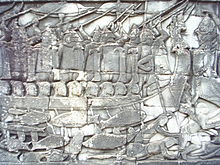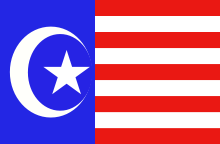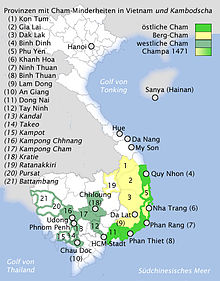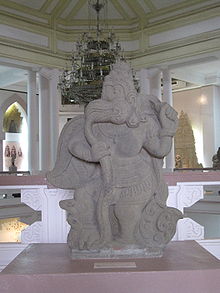- Cham people (Asia)
-
This article is about the Cham people of Asia. For the former ethnic Albanian minority of northern Greece, see Cham Albanians.
Cham
Urang Campa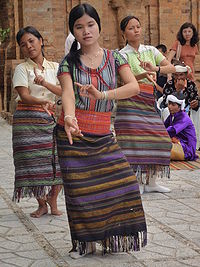
Cham dance performance at one of their temples in Nha Trang, Vietnam Total population ~500,000 Regions with significant populations  Cambodia
Cambodia317,000[1]  Vietnam
Vietnam127,000[2]  Laos
Laos15,000[2]  Malaysia
Malaysia10,000  Thailand
Thailand4,000  United States
United States3,000  France
France1,000 Languages Cham, Malay, Khmer, Vietnamese, Tamil
Religion Cambodian Cham: Predominately Sunni Muslim[3]
Vietnamese Cham: Predominately Hindu and Muslim[4][5]Related ethnic groups Jarai, Acehnese people, Malay and other Austronesian peoples of Southeast Asia.
The Cham people (Vietnamese: người Chăm or người Chàm, Cham: Urang Campa[6]) are an ethnic group in Southeast Asia. They are concentrated between the Kampong Cham Province in Cambodia and central Vietnam's Phan Rang-Thap Cham, Phan Thiết, Ho Chi Minh City and An Giang areas. Approximately 4,000 Chams also live in Thailand; many of whom have moved south to the Pattani, Narathiwat, Yala, and Songkhla Provinces for work. Cham form the core of the Muslim communities in both Cambodia and Vietnam.[3]
Cham are remnants of the Kingdom of Champa (7th to 15th centuries). They are closely related to other Austronesian peoples and speak Cham, a Malayo-Polynesian language of the Austronesian language family (Aceh–Chamic subgroup). This is in contrast to the neighboring Vietnamese people who speak the Vietnamese language, which is an Austroasiatic language.
Contents
History
Depiction of fighting Cham naval soldier against the Khmer, stone relief at the Bayon
The ancestors of the Cham probably migrated from the island of Borneo.[7] Records of the Champa kingdom go as far back as 2nd century AD. At its height in the 9th century, the kingdom controlled the lands between what is now modern Huế, to the northern reaches of the Mekong Delta in Southern Vietnam. Its prosperity came from maritime trade in sandalwood and slaves and probably included piracy.
Cham tradition claims that the founder of the Cham state was Lady Po Nagar. She originated from Khanh Hoa province, in a peasant family in the mountains of Dai An. Spirits assisted her when she sailed on a drift piece of sandalwood to China, where she married an heir to the royal family with whom she had 2 children with, and then became Queen of Champa.[8]
Al-Dimashqi (1325) states that "the country of Champa... is inhabited by Muslims and idolaters. The Muslim religion came there during the time of Caliph Uthman... and Ali, many Muslims who were expelled by the Umayyads and by Hajjaj, fled there."
The Daoyi Zhilue documents Chinese merchants who went to Cham ports in Champa, married Cham women, to whom they regularly returned to after trading voyages.[9] A Chinese merchant from Quanzhou, Wang Yuanmao, traded extensively with Champa, and married a Cham princess.[10]
In the 12th century AD, the Cham fought a series of wars with the Angkorian Khmer to the west. In 1177, the Cham and their allies launched an attack from the lake Tonlé Sap and managed to sack the Khmer capital. In 1181, however, they were defeated by the Khmer King Jayavarman VII.
Between the rise of the Khmer Empire around 800 and Vietnam's territorial push to the south, the Champa kingdom began to shrink. In the 1471 Vietnamese invasion of Champa it suffered a serious defeat at the hands of the Vietnamese, in which 120,000 people were either captured or killed, and the kingdom was reduced to a small enclave near Nha Trang. Between 1607 and 1676 the Champa king converted to Islam, and during this period Islam became a dominant feature of Cham society.
The Cham were matrilineal and inheritance passed through the mother.[11] Due to this, the Vietnamese in 1499 enacted a law banning marriage between Cham women and every single Vietnamese male, regardless of class.[12][13][14][15][16] The Vietnamese also issued instructions in the capital to kill all Chams within the vicinity.[17]
When the Ming dynasty in China fell, several thousand Chinese refugees fled south and extensively settled on Cham lands and in Cambodia.[18] Most of these Chinese were young males, and they took Cham women as wives. Their children identified more with Chinese culture. This migration occurred in the 17th and 18th centuries.[19]
Further expansion by the Vietnamese in 1720 resulted in the total annexation of the Champa kingdom and dissolution by the 19th century Vietnamese king, Minh Mạng. In response, the last Champa Muslim king, Pô Chien, gathered his people in the hinterland and fled south to Cambodia, while those along the coast migrated to Trengganu (Malaysia). A small group fled northward to the Chinese island of Hainan where they are known today as the Utsuls. Their refuge in Cambodia where the king and his people settled still bear the name of Kompong Cham (literally Cham landing); others scattered in communities across the Mekong Basin. Those who remained the Nha Trang, Phan Rang, Phan Rí, and Phan Thiết provinces of central Vietnam were absorbed into the Vietnamese polity.
In the 1960s various movements emerged calling for the creation of a separate Cham state in Vietnam. the Liberation Front of Champa (FLC – Le Front pour la Libération de Cham) and the Front de Libération des Hauts plateaux dominated. The latter group sought greater alliance with other hilltribe minorities.
Initially known as "Front des Petits Peuples" from 1946 to 1960, the group later took the designation "Front de Libération des Hauts plateaux" and joined, with the FLC, the "Front unifié pour la Libération des Races opprimées" (FULRO) at some point in the 1960s. Since the late 1970s, there is no serious Cham secessionist movement or political activity in Vietnam or Cambodia.
Genocide
The Cham community suffered a major blow during the Khmer Rouge rule. During the mass killings by the government, a disproportionate number of Chams were killed compared with ethnic Khmers.[20] Ysa Osman, a researcher at the Documentation Center of Cambodia concludes, "Perhaps as many as 500,000 died. They were considered the Khmer Rouge's No. 1 enemy. The plan was to exterminate them all" because "they stood out. They worshipped their own god. Their diet was different. Their names and language were different. They lived by different rules. The Khmer Rouge wanted everyone to be equal, and when the Chams practiced Islam they did not appear to be equal. So they were punished."[21]
21st century
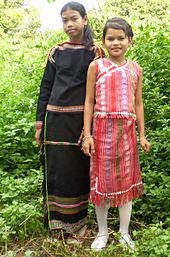 Young E De people, members of the mountain Cham
Young E De people, members of the mountain Cham
The majority of Cham in Vietnam (also known as the Eastern Cham) are Hindu, while their Cambodian counterparts are largely Muslim.[4][5] A small number of the Eastern Cham also follow Islam and to a lesser degree Mahayana Buddhism. A number emigrated to France in the late 1960s during the Vietnamese civil war.
The majority (88%) of Chams who reside in Cambodia are Muslim,[3] as are the Utsuls of Hainan. The isolation of Cham Muslims in central Vietnam resulted in an increased syncretism with Buddhism until recent restoration of contacts with other global Muslim communities in Vietnamese cities, but Islam is now seeing a renaissance, with new mosques being built. During the rule of the Khmer Rouge in Cambodia, the Chams of that country suffered serious purges with as much as half of their population exterminated. They suffered a higher rate of loss than any other ethnic group; with most of their leaders executed, only 21 out of 113 (19%) Imams surviving and perhaps only 15% of Cambodia’s mosques surviving.[22]
Malaysia has some Cham immigrants and the link between the Chams and the Malaysian state of Kelantan is an old one. The Malaysian constitution recognizes the Cham rights to Malaysian citizenship and their Bumiputra status, and the Cham communities in Malaysia and along the Mekong River in Vietnam continue to have strong interactions.
Around 98,971 Cham are estimated to live in Vietnam.[23]
The Acehnese people of Aceh province in Sumatra, Indonesia is descendant of Cham refugee who fled after defeat against Vietnamese in 15th century.[6][24]
Religion
The first[citation needed] religion of the Champa was a form of Shaivite Hinduism, brought by sea from India. As Arab merchants stopped along the Vietnam coast en route to China, Islam began to influence the civilization.
The exact date that Islam came to Champa is unknown, but grave markers dating to the 11th century have been found. It is generally assumed that Islam came to Indochina much after its arrival in China during the Tang Dynasty (618–907), and that Arab traders in the region came into direct contact only with the Chams, and not others. This might explain why only the Chams have been traditionally identified with Islam in Indochina.
Most Chams, especially in Cambodia, follow Islam and uphold its pillars including praying five times a day, fasting in Ramadan and performing hajj to Mecca. For many years, representatives from Cambodia have taken part in the annual International Quran Reciters Competition in Kuala Lumpur. The Cham Muslim community in Cambodia runs religious schools and is headed by a Mufti.
However, a small band of Chams, who called themselves Kaum Jumaat, follow a localised adaptation of Islamic theology, according to which they pray only on Fridays and celebrate Ramadan for only three days. However, some members of this group have joined the larger Muslim Cham community in their practices of Islam in recent years. One of the factors for this change is the influence by members of their family who have gone abroad to study Islam.
Most of the approximately 50,000 Cham Hindus belong to the Nagavamshi Kshatriya caste,[25] but a considerable minority are Brahmins.[26] Hindu temples are known as Bimong in Cham language and the priests are known as Halau Tamunay Ahier. In Ninh Thuan Province, where many of the Cham in Vietnam reside, Cham Balamon (Hindu Cham) numbers 32,000 while Cham Bani (Muslim Cham) number close to 22,000. Out of the 22 villages in Ninh Thuan, 15 are Hindu, while 7 are Muslim.[27]
Notable Chams
- Chế Bồng Nga, the last strong king of Champa
- Che Linh, singer
See also
- Art of Champa
- Cham script
- Cham language
- Islam in Cambodia
- Islam in Vietnam
- Hinduism in Vietnam
References
- ^ The Joshua Project
- ^ a b Cambodia’s Western Cham People
- ^ a b c http://worldmap.org/maps/other/profiles/cambodia/Cambodia%20Country%20Profile.pdf
- ^ a b http://www.everyculture.com/wc/Tajikistan-to-Zimbabwe/Cham.html
- ^ a b The Garland handbook of Southeast Asian music By Terry E. Miller, Sean Williams. Pg. 326
- ^ a b Andaya, Leonard Y. (2008). Leaves of the same tree: trade and ethnicity in the Straits of Melaka. University of Hawaii Press. pp. 44. ISBN 0824831896, 9780824831899. http://books.google.com/books?id=w7AqZR1ZUZgC&pg=PA45.
- ^ Anne-Valérie Schweyer Le Viêtnam ancien (Les Belles Lettres, 2005) p.6
- ^ Oscar Chapuis (1995). A history of Vietnam: from Hong Bang to Tu Duc. Greenwood Publishing Group. p. 39. ISBN 0313296227. http://books.google.com/books?id=Jskyi00bspcC&pg=PA39&dq=lin+yi+cham+tradition+lady+po+nagar+cham+nation+china+champa&hl=en&ei=uJvPTP24EoSBlAe8kL3fBg&sa=X&oi=book_result&ct=result&resnum=1&ved=0CC8Q6AEwAA#v=onepage&q=lin%20yi%20cham%20tradition%20lady%20po%20nagar%20cham%20nation%20china%20champa&f=false. Retrieved 2010-06-28.
- ^ Derek Heng (2009). Sino-Malay Trade and Diplomacy from the Tenth Through the Fourteenth Century. Ohio University Press. p. 133. ISBN 089680271X. http://books.google.com/books?id=cLE_ToRyuLsC&pg=PA133&dq=southeast+asian+ports+intermarriage+daoyi+zhilue+champa+chinese+traders+local+women+cham+ports&hl=en&ei=jp7PTPjdBMP7lwev-ZmrBg&sa=X&oi=book_result&ct=result&resnum=1&ved=0CCcQ6AEwAA#v=onepage&q=southeast%20asian%20ports%20intermarriage%20daoyi%20zhilue%20champa%20chinese%20traders%20local%20women%20cham%20ports&f=false. Retrieved 2010-06-28.
- ^ Robert S. Wicks (1992). Money, markets, and trade in early Southeast Asia: the development of indigenous monetary systems to AD 1400. SEAP Publications. p. 215. ISBN 0877277109. http://books.google.com/books?id=Qs1q9VEoEkoC&pg=PA215&dq=chinese+merchant+champa+wang+yuanmao+quanzhou+man+king+barbarian+daughters&hl=en&ei=_XrQTJf9BsH6lwet8-SMBg&sa=X&oi=book_result&ct=result&resnum=1&ved=0CCoQ6AEwAA#v=onepage&q=chinese%20merchant%20champa%20wang%20yuanmao%20quanzhou%20man%20king%20barbarian%20daughters&f=false. Retrieved 2010-06-28.
- ^ M. B. Hooker, Institute of Southeast Asian Studies (2002). Law and the Chinese in Southeast Asia. Institute of Southeast Asian Studies. p. 75. ISBN 9812301259. http://books.google.com/books?id=jzuKi8RWYy0C&pg=PA75&dq=confucian+cham+women+marry&hl=en&ei=nh3QTaXLAtLpgQePhKTLDA&sa=X&oi=book_result&ct=result&resnum=2&ved=0CDsQ6AEwAQ#v=onepage&q&f=false. Retrieved 2011-05-15.
- ^ Ben Kiernan (2009). Blood and Soil: A World History of Genocide and Extermination from Sparta to Darfur. Yale University Press. p. 111. ISBN 0300144253. http://books.google.com/books?id=Bc30ytJmwzMC&pg=PA111&dq=forbade+cham+women+marry+vietnamese&hl=en&ei=43UrTf6aKcK78ga41NjsAQ&sa=X&oi=book_result&ct=result&resnum=1&ved=0CCoQ6AEwAA#v=onepage&q&f=false. Retrieved 2011-01-09.
- ^ Văn Tài Tạ (1988). The Vietnamese tradition of human rights. Institute of East Asian Studies, University of California. p. 137. ISBN 1557290024. http://books.google.com/books?id=6qqaAAAAIAAJ&q=forbade+everyone,+%22from+princes+down+to+the+common+people,%22+from+marrying+women+of+the+Cham+race,239+it+was+also+based+on+national+security&dq=forbade+everyone,+%22from+princes+down+to+the+common+people,%22+from+marrying+women+of+the+Cham+race,239+it+was+also+based+on+national+security&hl=en&ei=g40rTZv4GcH38Abnh8T_AQ&sa=X&oi=book_result&ct=result&resnum=1&ved=0CCMQ6AEwAA. Retrieved 2011-01-09.
- ^ Barbara Watson Andaya (2006). The flaming womb: repositioning women in early modern Southeast Asia. University of Hawaii Press. p. 82. ISBN 0824829557. http://books.google.com/books?id=tClCMl7hswQC&pg=PA82&dq=forbade+cham+women+marry+vietnamese&hl=en&ei=43UrTf6aKcK78ga41NjsAQ&sa=X&oi=book_result&ct=result&resnum=4&ved=0CDkQ6AEwAw#v=onepage&q&f=false. Retrieved 2011-01-09.
- ^ Yale University, Southeast Asia Studies (1985). The Vietnam forum, Issues 5-7. Council on Southeast Asia Studies at Yale University. p. 28. http://books.google.com/books?id=f3FuAAAAMAAJ&q=from+wedding+women+of+the+Cham+race,35+it+was+also+based+on+national+security+considerations&dq=from+wedding+women+of+the+Cham+race,35+it+was+also+based+on+national+security+considerations&hl=en&ei=jY0rTez5F8KB8gbpqPWGAg&sa=X&oi=book_result&ct=result&resnum=1&ved=0CCgQ6AEwAA. Retrieved 2011-01-09.
- ^ Teresa A. Meade, Merry E. Wiesner-Hanks (2006). A companion to gender history. Wiley-Blackwell. p. 332. ISBN 1405149604. http://books.google.com/books?id=Ilqhy4Z3iwEC&pg=PA332&dq=forbade+cham+women+marry+vietnamese&hl=en&ei=43UrTf6aKcK78ga41NjsAQ&sa=X&oi=book_result&ct=result&resnum=2&ved=0CC8Q6AEwAQ#v=onepage&q&f=false. Retrieved 2011-01-09.
- ^ Victor B. Lieberman (2003). Strange parallels: Southeast Asia in global context, c 800-1830, Volume 1 (illustrated ed.). Cambridge University Press. p. 381. ISBN 0521804965. http://books.google.com/books?id=nZNHHDMqiZgC&pg=PA381&dq=confucian+cham+women+marry&hl=en&ei=nh3QTaXLAtLpgQePhKTLDA&sa=X&oi=book_result&ct=result&resnum=1&ved=0CDYQ6AEwAA#v=onepage&q&f=false. Retrieved 2011-05-15.
- ^ Encyclopaedia Britannica, inc (2003). The New Encyclopaedia Britannica, Volume 8. Encyclopaedia Britannica. p. 669. ISBN 0852299613. http://books.google.com/books?id=FP7iAAAAMAAJ&q=Much+of+the+settlement+of+Cham+and+Cambodian+lands,+however,+was+done+by+Chinese+refugees+fleeing+the+collapse+of+the+Ming+dynasty.+The+Chinese+were+actively+courted+by+the+Nguyen,+who+were+in+desperate+need+of+manpower+in+order+to&dq=Much+of+the+settlement+of+Cham+and+Cambodian+lands,+however,+was+done+by+Chinese+refugees+fleeing+the+collapse+of+the+Ming+dynasty.+The+Chinese+were+actively+courted+by+the+Nguyen,+who+were+in+desperate+need+of+manpower+in+order+to&hl=en&ei=dc27TJK-N8T_lgf09p30DA&sa=X&oi=book_result&ct=result&resnum=1&ved=0CCgQ6AEwAA. Retrieved 2010-06-28.
- ^ Barbara Watson Andaya (2006). The flaming womb: repositioning women in early modern Southeast Asia. University of Hawaii Press. p. 146. ISBN 0824829557. http://books.google.com/books?id=tClCMl7hswQC&pg=PA146&dq=southern+vietnam+thousands+of+young+chinese+males+brides+cham+communities&hl=en&ei=V3rQTKjWMoKdlged-pDkBg&sa=X&oi=book_result&ct=result&resnum=1&ved=0CC0Q6AEwAA#v=onepage&q=southern%20vietnam%20thousands%20of%20young%20chinese%20males%20brides%20cham%20communities&f=false. Retrieved 2010-06-28.
- ^ Kate McGeown. Laos' forgotten Hmong, BBC, 2 July 2003 "Andrew Perrin, a journalist from Time Asia magazine"
- ^ Andrew Perrin, Weakness in Numbers: Muslim minorities across Asia are under siege—and their persecution fuels fundamentalists, Time, 10 March 2003, p.1,,2
- ^ Cambodia and Islamism: Courting the Cham: A cultural revival gathers pace. So do worries about fundamentalism, The Economist, dated Sep 30th 2010, PHNOM PENH.
- ^ Philip Taylor (2007). Cham Muslims of the Mekong Delta: place and mobility in the cosmopolitan periphery. NUS Press. p. 59. ISBN 9971693615. http://books.google.com/books?id=a5YntZEIUHMC&dq=islam+is+to+many+cham+synonymous+with+widened+horizons&q=marriage#v=onepage&q=98971&f=false. Retrieved 2011-01-09.
- ^ Reid, Anthony (2006). Verandah of violence: the background to the Aceh problem. NUS Press. pp. 8. ISBN 9971693313, 9789971693312. http://books.google.com/books?id=PfF8Y9nZE3oC&pg=PA8.
- ^ India's interaction with Southeast Asia, Volume 1, Part 3 By Govind Chandra Pande, Project of History of Indian Science, Philosophy, and Culture, Centre for Studies in Civilizations (Delhi, India) p.231,252
- ^ http://www.state.gov/g/drl/rls/irf/2004/35433.htm
- ^ Champa and the archaeology of Mỹ Sơn (Vietnam) by Andrew Hardy, Mauro Cucarzi, Patrizia Zolese p.105
Literature
- Antoine Cabaton (1901). Nouvelles recherches sur les Chams. Volume 2 of Publications de l'École française d'Extrême-Orient. E. Leroux. http://books.google.com/books?id=DIsoAAAAYAAJ&printsec=frontcover&source=gbs_ge_summary_r&cad=0#v=onepage&q&f=false. Retrieved 2011-05-15.
- Étienne Aymonier (1891). Les Tchames et leurs religions. E. Leroux. http://books.google.com/books?id=R_kuAAAAYAAJ&printsec=frontcover&source=gbs_ge_summary_r&cad=0#v=onepage&q&f=false. Retrieved 2011-05-15.
- Taylor, Philip (2007) Cham Muslims of the Mekong Delta: Place and Mobility in the Cosmopolitan Periphery, Singapore: University of Singapore Press.
- Dổ Hải Minh (1965) "Dân Tộc Chàm Lược sử" Saigon.
- Hourani, George F. (1979) "Arab Seafaring" Princeton University Press, New Jersey.
- Tarling, Nicholas (1992) "The Cambridge History of Southeast Asia" vol.1 Cambridge University Press, Cambridge.
- Salim, Maryam. (2005) "The Laws of Kedah, 220 Hijrah" A text translation from jawi script to rumi script Dewan Bahasa dan Pustaka, Malaysia.
External links
- Britannica | Cham people
- Cham Muslims of the Mekong Delta Book by Philip Taylor about the settlement history, religion, economic life and political relations of the Cham Muslims in the Mekong delta of Vietnam
- Proceedings of the Seminar on Champa
- Vietnam-Champa Relations and the Malay-Islam Regional Network in the 17th—19th Centuries
- The Survivors of a Lost Civilisation
- Cham Muslims: A look at Cambodia's Muslim minority
- The Cham Muslims of Indo-China
- Article about the Cham people living in Ratanakiri Province, Cambodia by Antonio Graceffo
- Article about Cham fishermen living near Mekong Island, Cambodia by Antonio Graceffo
- Stone carvings at Bayon in Cambodia showing a battle between the Khmer and the Cham
- The face of Islam in a Buddhist land, by Murat Karaali, Phnom Penh Post, January 1995
- Chamstudies, a new site on Chams
- Picture of Muslim cham girls
- Radio Sapcham
Ethnic groups in Cambodia by language family Cambodian 
Chinese people Malayo-Polynesian Khmer Loeu Tai peoples Hmong-Mien Tibeto-Burman Other Indians · VietnameseEthnic groups in Vietnam by language family Categories:- Cambodian Hindus
- Cham people
- Ethnic groups in Asia
- Ethnic groups in Cambodia
- Ethnic groups in Malaysia
- Ethnic groups in Thailand
- Ethnic groups in Vietnam
- Muslim communities
- Former hindu communities
Wikimedia Foundation. 2010.


